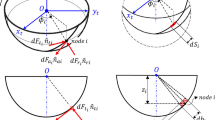Abstract
The contribution discusses the use of combining the methods of neural networks, fuzzy logic and PSO evolutionary strategy in modeling and adaptively controlling the process of ball-end milling. On the basis of the hybrid process modeling, off-line optimization and feed-forward neural control scheme (UNKS) the combined system for off-line optimization and adaptive adjustment of cutting parameters is built. This is an adaptive control system controlling the cutting force and maintaining constant roughness of the surface being milled by digital adaptation of cutting parameters. In this way it compensates all disturbances during the cutting process: tool wear, non-homogeneity of the workpiece material, vibrations, chatter, etc. The basic control principle is based on the control scheme (UNKS) consisting of two neural identifiers of the process dynamics and primary regulator. An overall procedure of hybrid modeling of cutting process used for creating the CNC milling simulator has been prepared. The experimental results show that not only does the milling system with the design controller have high robustness, and global stability, but also the machining efficiency of the milling system with the adaptive controller is 27% higher than for traditional CNC milling system.
Similar content being viewed by others
References
Altintas Y. (1994) Direct adaptive control of end milling process. International Journal of Machine Tools and Manufacture 34(4): 461–472
Balic J. (2000) A new NC machine tool controller for step-by-step milling. The International Journal, Advanced Manufacturing Technology 8: 399–403
Balic J., Kovacic M., Vaupotic B. (2006) Intelligent programming of CNC turning operations using genetic algorithm. Journal of Intelligent Manufacturing 17(3): 331–340
Cus F., Balic J. (2005) Optimization of cutting process by GA approach. Robotics and Computer-Integrated Manufacturing 19: 113–121
Cus F., Zuperl U., Kiker E. (2007) A model-based system for the dynamic adjustment of cutting parameters during a milling process. Journal of Mechanical Engineering 53(9): 524–540
Desforges X., Habbadi A., Geneste L., Soler F. (2004) Distributed machining control and monitoring using smart sensors/actuators. Journal of Intelligent Manufacturing 15(1): 39–53
Dobrzański L. A., Śliwa A., Kwaśny W. (2005) Employment of the finite element method for determining stresses in coatings obtained on high-speed steel with the PVD process. Journal of Materials Processing Technology 164: 1192–1196
Egresits C., Monostori L., Hornyak J. (1998) Multistrategy learning approaches to generate and tune fuzzy control structures and their application in manufacturing. Journal of Intelligent Manufacturing 9(4): 323–329
Huang S. J., Lin C. C. (2002) A self-organising fuzzy logic controller for a coordinate machine. The International Journal, Advanced Manufacturing Technology 19: 736–742
Huang S., Tan K. K., Hong G. S., Wong Y. S. (2007) Cutting force control of milling machine. Mechatronics 17(10): 533–541
Jee S., Koren Y. (2004) Adaptive fuzzy logic controller for feed drivers of a CNC machine tool. Mechatronics 6(3): 299–326
Kubota N., Fukuda T. (1999) Structured intelligence for self-organizing manufacturing systems. Journal of Intelligent Manufacturing 10(2): 121–133
Laduerbaugh L. K., Ulsoy A. G. (1989) Model reference adaptive control in milling. ASME Journal Engineering Industries 111(1): 13–21
Landers R. G., Ulsoy A. G., Ma Y. H. (2004) A comparison of model-based machining force control approaches. International Journal of Machine Tools and Manufacture 44(7–8): 733–748
Lee T. H., Tan K. K., Huang S. (2010) Adaptive friction compensation with a dynamical friction model. IEEE ASME Transactions on Mechatronics 9: 11–18
Liu Y., Zuo L., Wang C. (1999) Intelligent adaptive control in milling process. International Journal of Computer Integrated Manufacturing 12: 453–460
Ma C. C. H., Altintas Y. (1990) Direct adaptive cutting force control of milling processes. Automatica 26(5): 899–902
Milfelner M., Kopac J., Cus F., Zuperl U. (2005) Genetic equation for the cutting force in ball-end milling. Journal of Materials Processing Technology 164: 1554–1560
Mohammadian M., Amin X. Y. (2002) Computational intelligence in control. IGI Global, London
Quintana, G., Romeu, M. L. G., & Ciurana, J. (2009). Surface roughness monitoring application based on artificial neural networks for ball-end milling operations. Journal of Intelligent Manufacturing, Online FirstTM (2009, October 15)
Sanner R. M., Stoline J. J. E. (1992) Gaussian networks for direct adaptive control. IEEE Transactions on Neural Networks 3(6): 837–863
Tarng Y. S., Cheng S. T. (1993) Fuzzy control of feed rate in end milling operations. International Journal of Machine Tools and Manufacture 33(4): 643–650
Tarng Y. S., Hwang S. T. (1995) Adaptive learning control of milling operations. Mechatronics 5(8): 937–948
Tomizuka M., Oh J. H., Dornfeld D. A. (1983) Model reference adaptive control of the milling process. In: Hardt D. E., Book W. J. (eds) Control of manufacturing processors and robotic systems. ASME, New York
Tsai, N. C., Shih, L. W., & Lee, R. M. (2009). Position regulator for spindle of milling machine by embedded magnetic bearings. Journal of Intelligent Manufacturing, Online FirstTM (2009, September 24).
Zuperl U., Cus F. (2003) Optimization of cutting conditions during cutting by using neural networks. Robotics and Computer-Integrated Manufacturing 19: 189–199
Zuperl U., Cus F. (2004) Tool cutting force modeling in ball-end milling using multilevel perceptron. Journal of Materials Processing Technology 153/154: 268–275
Zuperl U., Cus F., Gecevska V. (2007) Optimization of the characteristic parameters in milling using the PSO evolution technique. Journal of Mechanical Engineering 6(53): 354–368
Author information
Authors and Affiliations
Corresponding author
Rights and permissions
About this article
Cite this article
Zuperl, U., Cus, F. & Reibenschuh, M. Modeling and adaptive force control of milling by using artificial techniques. J Intell Manuf 23, 1805–1815 (2012). https://doi.org/10.1007/s10845-010-0487-z
Received:
Accepted:
Published:
Issue Date:
DOI: https://doi.org/10.1007/s10845-010-0487-z



